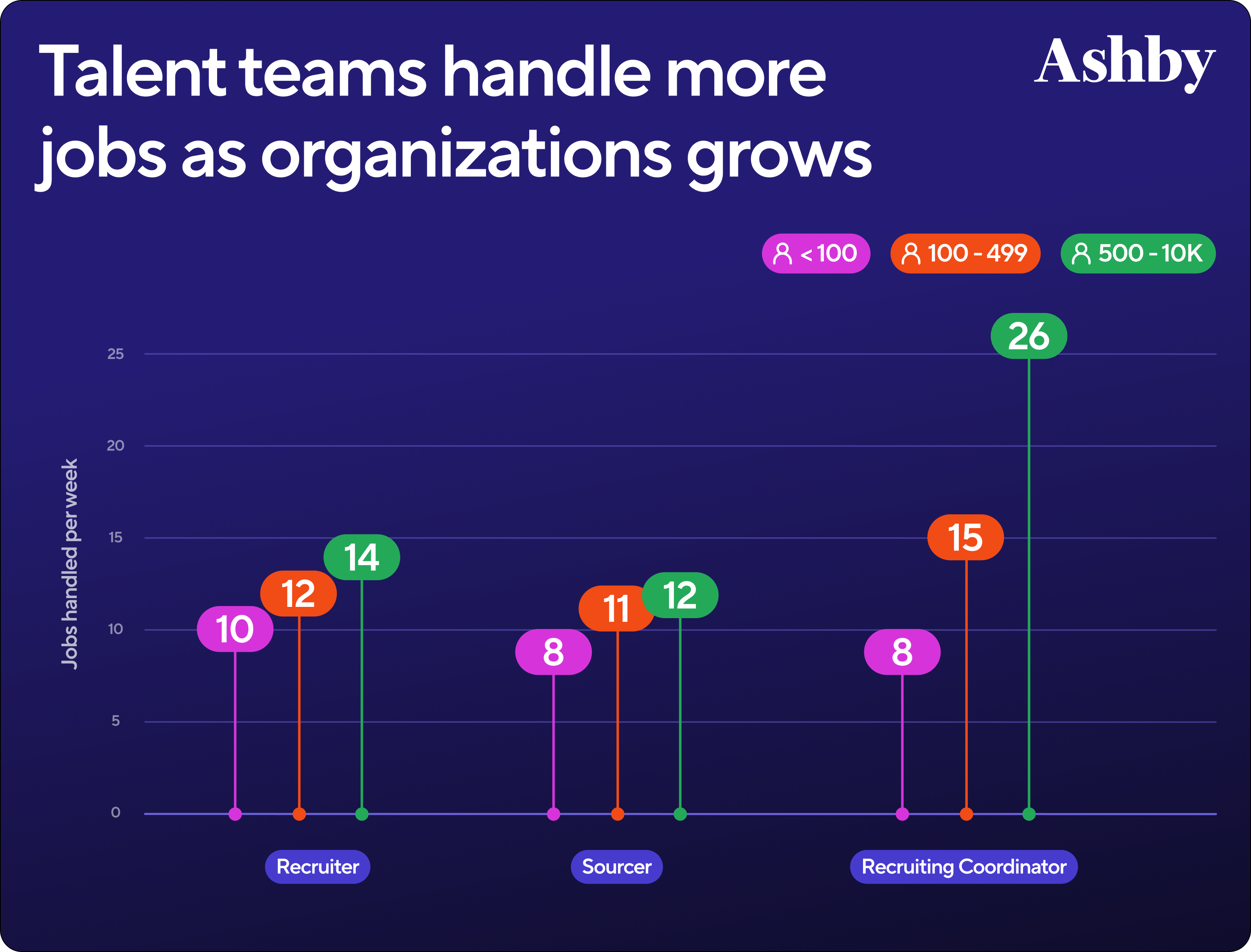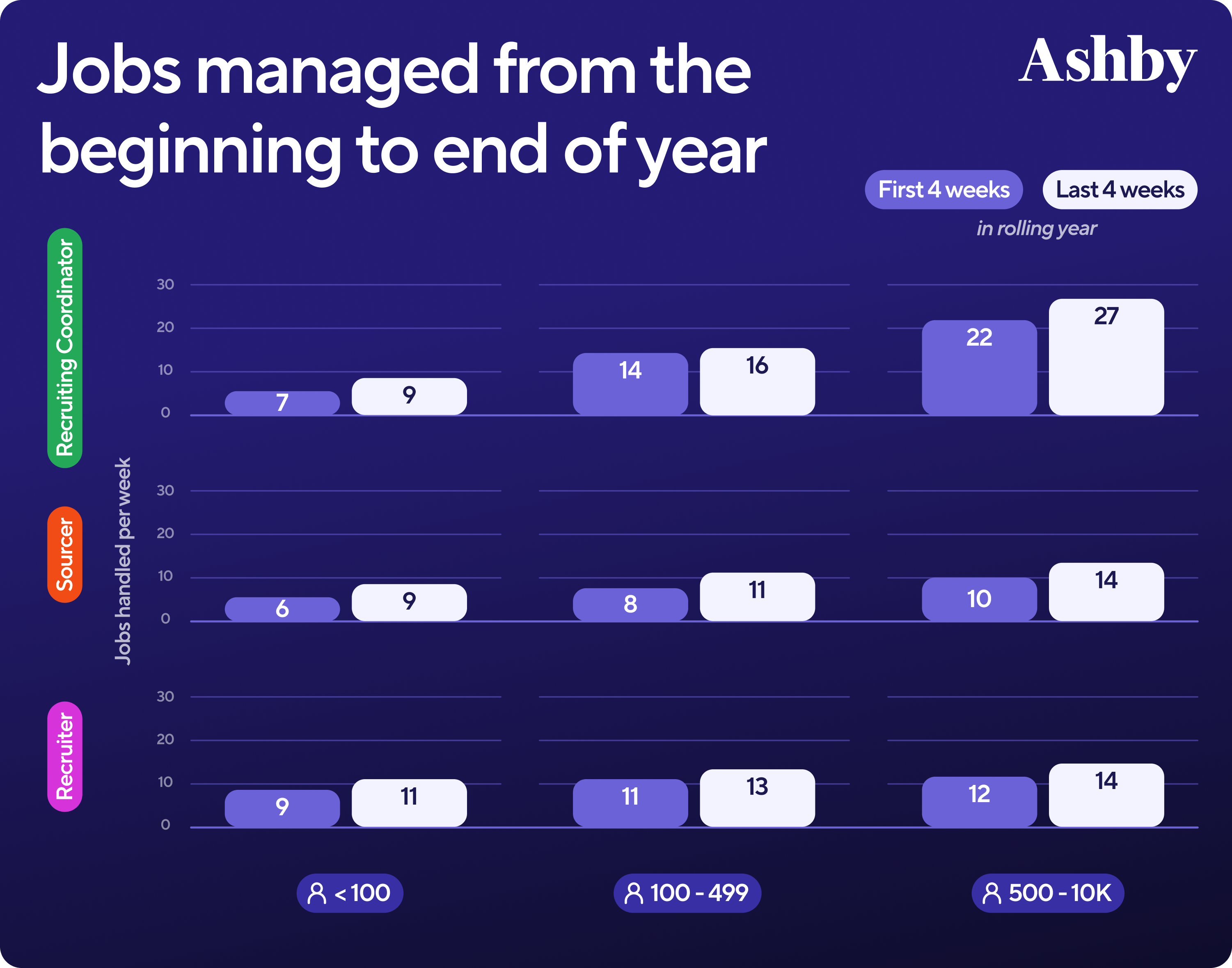7 minute read
Topics
One of the most predictable areas of responsibility for a Talent Leader is capacity planning. The planning itself though? Far less predictable. And to date, there hasn’t been an industry standard for what this can look like.
While no single benchmark will be perfect as every team, company, and role comes with its own unique set of challenges, we tried to find something directionally helpful. This analysis aims to be a directional guide and should be applied with the unique context of your team.
How We Defined Recruiter Capacity
We examined weekly data from thousands of talent professionals, including over 26M interactions and 100K jobs. Interactions here are pulled from application stage transitions, including activity such as :
- App review
- Emails directly mappable to a job
- Interviews with a status of accepted or tentative
- Interviews scheduled
In other words, we define recruiter capacity through activity by pulling the active jobs a talent professional worked on that week. So while you could be responsible for 40 jobs that quarter, you may have only been working actively on three in said week. Said another way, we analyzed how many jobs a talent professional is managing in an active way each week.
The findings below focus on the 90th percentile at the recruiter/week level as a proxy for what capacity could be, since an individual talent professional might not be “at capacity” for all weeks.
Benchmarking Recruiter Capacity
This report analyzes over 26M interactions with a job from November 2024 to August 2025.
1. As companies grow, their talent teams handle more jobs in parallel.
While somewhat expected, the data shows that talent professionals are involved with more jobs as a company grows. The most efficiencies in capacity are seen with Recruiting Coordinators, who can handle 3x more jobs at an enterprise organization than at an organization with fewer than 100 employees. That said, it’s also likely that RCs at a smaller organization are handling very different scopes of work than those at a larger enterprise, which could be an influence into how many jobs can be worked at once.

2. Recruiting Coordinators handle the most jobs in any given week.
At peak capacity (90th percentile, week level):
- RCs interact with 27 jobs
- Recruiters & Sourcers interact with 14 jobs

To understand what efficiencies RCs are seeing, we spoke with Gabrielle Crosby-Stepter and Jessica Mikler, who both work in Talent Operations at Mapbox. After raising a $280M in Series E funding, the team began noticing a rapid increase in interview volume. Within a year, interview volume jumped 150%, requiring coordinators to take on far more capacity. To address this, a few steps were taken. Two of which include:
- Increasing coordination support: The team is now four coordinators, Gabrielle and Jessica in the U.S. alongside with two counterparts in EMEA.
- Improving technology stack: The team adopted Ashby’s Enterprise plan, which unlocked more Scheduling functionality to free up time for the existing coordinators.
Both Jessica and Gabrielle use Auto Scheduling in Ashby to manage multi-panel and multi-event scheduling, even as demands increase.
“With Ashby’s Auto Scheduling, I can easily drag interviews up two hours, automatically collect availability, change and convert time zones, and provide other interviews depending on if the candidate is on the east or west coast.”
— Jessica Mikler, Talent Operations Consultant at Mapbox
“The recent update on shared queues for scheduling requests is one of many ways I’m able to reduce the amount of clicks needed to do a certain task — and that adds up. Even something as minor as my recently used email templates populating at the top of the email instead of scrolling through to find it saves me five extra seconds. And five seconds times 100 interviews… eight minutes saved just that day. These little wins matter.”
— Gabrielle Crosby-Stepter, Talent Operations Specialist at Mapbox
3. Talent professionals are handling more jobs now than they were nine months ago.
Looking again at the 90th percentile across the last nine months, we see an upward trend in recruiter capacity. At the start of the period, the busiest RCs were actively managing around 22 jobs per week; today that number is closer to 27.
There could be a variety of reasons behind these efficiencies, especially in the “do more with less” era. In a previous report on Recruiting Coordination, we shared how automations in Ashby led to scheduling interviews 40% faster compared to legacy systems. This provides just one example of how RCs are leveraging technology for improved efficiency.

4. Capacity is relatively steady throughout the year, outside the holiday season.
At the industry level, we don’t see major swings. The 90th percentile of jobs handled per week holds steady across the year, with the expected holiday dip.
That said, this steadiness doesn’t always translate within individual companies. For example, a recruiter at a small organization might spend a few weeks in the 90th percentile during a hiring spree, and then drop out of it once hiring slows. In other words, while the data shows consistency across the market, individual recruiter experiences can look much more variable.
To understand how often recruiters operate at peak capacity, we looked at how many spend time in the 90th percentile of jobs handled per week. About a third of talent professionals reached this level at least once during the year, and over half of all organizations had someone hit that mark. In other words, high-demand weeks are a shared experience across teams — but they tend to come and go, rather than remain steady throughout the year.
If your company wants to plan for downtime, consider hearing from JT Haskell, a talent acquisition leader with over 15 years of experience at companies such as Reddit, Zapier, and Kraken. As a guest on the Offer Accepted podcast, JT walks through accounting for planned time off in capacity planning.
For more snackable insights on recruiting trends, subscribe to our Talent Trends newsletter.